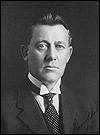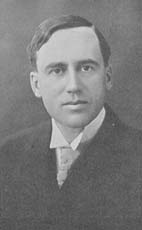|
John Michael Uhrich
John Michael Uhrich (June 7, 1877 – June 15, 1951), was the ninth Lieutenant Governor of Saskatchewan from 1948 until 1951. Early life Uhrich was born in Formosa, Ontario and received his schooling in Walkerton and was briefly a schoolteacher before earning his medical degree at Northwestern University in Chicago. During his summer breaks from university he would teach school in Saskatchewan. After graduation, he decided to settle in the province and established his medical practice at Hague, Saskatchewan in 1909. Politics He entered politics and was elected to the Legislative Assembly of Saskatchewan in the 1921 provincial election as the Liberal MLA for Rosthern. Uhrich was appointed to the provincial cabinet in 1922 by Premier Charles Dunning and served as provincial secretary until 1923 when he was appointed the province's first Minister of Public Health. Under Uhrich the province expanded its role in the hospital system, which had been largely locally run to that p ... [...More Info...] [...Related Items...] OR: [Wikipedia] [Google] [Baidu] |
The Honourable
''The Honourable'' (British English) or ''The Honorable'' (American English; see spelling differences) (abbreviation: ''Hon.'', ''Hon'ble'', or variations) is an honorific style that is used as a prefix before the names or titles of certain people, usually with official governmental or diplomatic positions. Use by governments International diplomacy In international diplomatic relations, representatives of foreign states are often styled as ''The Honourable''. Deputy chiefs of mission, , consuls-general and consuls are always given the style. All heads of consular posts, whether they are honorary or career postholders, are accorded the style according to the State Department of the United States. However, the style ''Excellency'' instead of ''The Honourable'' is used for ambassadors and high commissioners. Africa The Congo In the Democratic Republic of the Congo, the prefix 'Honourable' or 'Hon.' is used for members of both chambers of the Parliament of the Democratic Repu ... [...More Info...] [...Related Items...] OR: [Wikipedia] [Google] [Baidu] |
Chicago
(''City in a Garden''); I Will , image_map = , map_caption = Interactive Map of Chicago , coordinates = , coordinates_footnotes = , subdivision_type = Country , subdivision_name = United States , subdivision_type1 = State , subdivision_type2 = Counties , subdivision_name1 = Illinois , subdivision_name2 = Cook and DuPage , established_title = Settled , established_date = , established_title2 = Incorporated (city) , established_date2 = , founder = Jean Baptiste Point du Sable , government_type = Mayor–council , governing_body = Chicago City Council , leader_title = Mayor , leader_name = Lori Lightfoot ( D) , leader_title1 = City Clerk , leader_name1 = Anna Valencia ( D) , unit_pref = Imperial , area_footnotes = , area_tot ... [...More Info...] [...Related Items...] OR: [Wikipedia] [Google] [Baidu] |
1934 Saskatchewan General Election
The 1934 Saskatchewan general election was held on June 19, 1934, to elect members of the Legislative Assembly of Saskatchewan. The Liberal Party of Saskatchewan, Liberal Party of former List of premiers of Saskatchewan, Premier James Garfield Gardiner, James Gardiner was returned to power with a large majority – 50 of the 55 seats in the legislature – after the four year Conservative minority government interlude. After forming a coalition government to oust the Liberals from power after the 1929 Saskatchewan general election, 1929 election, James Thomas Milton Anderson, James T.M. Anderson's Progressive Conservative Party of Saskatchewan, Conservative government had tried to use anti-Roman Catholic Archdiocese of Regina, Catholic and anti-Fransaskois, French Canadian feeling in the province to win support. The Conservatives also had the support of the Ku Klux Klan in Canada, Ku Klux Klan, which was a significant force in the province at the time.Weedmark, Kevin"When the KKK ... [...More Info...] [...Related Items...] OR: [Wikipedia] [Google] [Baidu] |
1929 Saskatchewan General Election
The 1929 Saskatchewan general election was held on June 6, 1929 to elect members of the Legislative Assembly of Saskatchewan. As a result of corruption scandals, the Liberal Party of Premier James Gardiner lost a significant share of its popular vote, but more important, lost twenty-two of the seats it had won in the 1925 election. While the Liberals held the largest number of seats in the legislature, they had only a minority. Gardiner tried to continue as a minority government, but was quickly defeated in a Motion of No Confidence, and resigned as premier. The Conservative Party of James T.M. Anderson increased its representation in the legislature from three to twenty four seats. Following Gardiner's resignation, Anderson was able to form a coalition government with the support of the Progressive Party and some independents. The Progressives had lost a large part of the popular vote it had won in 1925, but managed to retain five of the six seats it had won previously. Resu ... [...More Info...] [...Related Items...] OR: [Wikipedia] [Google] [Baidu] |
1925 Saskatchewan General Election
The 1925 Saskatchewan general election was held on June 2, 1925 to elect members of the Legislative Assembly of Saskatchewan. The Liberal Party of Saskatchewan – under its new leader, Charles A. Dunning – won its sixth consecutive victory, and continued to dominate the legislature. The Progressive Party of Saskatchewan increased its share of the vote from 7.5% to over 23%, but failed to add to its six member caucus. The Conservative Party of James Anderson also increased its vote by over 14%, but only increased its representation in the legislature from two to three members. The increase in the Progressive and Conservative vote came from voters who had supported independent candidates in the 1921 election. Results Note:* Party did not nominate candidates in previous election. Percentages Members elected For complete electoral history, see individual districts July 21, 1925 For complete electoral history, see individual districts See also * List of Saskatchewan po ... [...More Info...] [...Related Items...] OR: [Wikipedia] [Google] [Baidu] |
Tuberculosis
Tuberculosis (TB) is an infectious disease usually caused by '' Mycobacterium tuberculosis'' (MTB) bacteria. Tuberculosis generally affects the lungs, but it can also affect other parts of the body. Most infections show no symptoms, in which case it is known as latent tuberculosis. Around 10% of latent infections progress to active disease which, if left untreated, kill about half of those affected. Typical symptoms of active TB are chronic cough with blood-containing mucus, fever, night sweats, and weight loss. It was historically referred to as consumption due to the weight loss associated with the disease. Infection of other organs can cause a wide range of symptoms. Tuberculosis is spread from one person to the next through the air when people who have active TB in their lungs cough, spit, speak, or sneeze. People with Latent TB do not spread the disease. Active infection occurs more often in people with HIV/AIDS and in those who smoke. Diagnosis of active TB is ... [...More Info...] [...Related Items...] OR: [Wikipedia] [Google] [Baidu] |
Smallpox
Smallpox was an infectious disease caused by variola virus (often called smallpox virus) which belongs to the genus Orthopoxvirus. The last naturally occurring case was diagnosed in October 1977, and the World Health Organization (WHO) certified the global eradication of the disease in 1980, making it the only human disease to be eradicated. The initial symptoms of the disease included fever and vomiting. This was followed by formation of ulcers in the mouth and a skin rash. Over a number of days, the skin rash turned into the characteristic fluid-filled blisters with a dent in the center. The bumps then scabbed over and fell off, leaving scars. The disease was spread between people or via contaminated objects. Prevention was achieved mainly through the smallpox vaccine. Once the disease had developed, certain antiviral medication may have helped. The risk of death was about 30%, with higher rates among babies. Often, those who survived had extensive scarring of their ... [...More Info...] [...Related Items...] OR: [Wikipedia] [Google] [Baidu] |
Diphtheria
Diphtheria is an infection caused by the bacterium '' Corynebacterium diphtheriae''. Most infections are asymptomatic or have a mild clinical course, but in some outbreaks more than 10% of those diagnosed with the disease may die. Signs and symptoms may vary from mild to severe and usually start two to five days after exposure. Symptoms often come on fairly gradually, beginning with a sore throat and fever. In severe cases, a grey or white patch develops in the throat. This can block the airway and create a barking cough as in croup. The neck may swell in part due to enlarged lymph nodes. A form of diphtheria which involves the skin, eyes or genitals also exists. Complications may include myocarditis, inflammation of nerves, kidney problems, and bleeding problems due to low levels of platelets. Myocarditis may result in an abnormal heart rate and inflammation of the nerves may result in paralysis. Diphtheria is usually spread between people by direct contact or through th ... [...More Info...] [...Related Items...] OR: [Wikipedia] [Google] [Baidu] |
Immunization
Immunization, or immunisation, is the process by which an individual's immune system becomes fortified against an infectious agent (known as the immunogen). When this system is exposed to molecules that are foreign to the body, called ''non-self'', it will orchestrate an immune response, and it will also develop the ability to quickly respond to a subsequent encounter because of immunological memory. This is a function of the adaptive immune system. Therefore, by exposing a human, or an animal, to an immunogen in a controlled way, its body can learn to protect itself: this is called active immunization. The most important elements of the immune system that are improved by immunization are the T cells, B cells, and the antibodies B cells produce. Memory B cells and memory T cells are responsible for a swift response to a second encounter with a foreign molecule. Passive immunization is direct introduction of these elements into the body, instead of production of these elements b ... [...More Info...] [...Related Items...] OR: [Wikipedia] [Google] [Baidu] |
Charles Dunning
Charles Avery Dunning (July 31, 1885 – October 1, 1958) was the third premier of Saskatchewan. Born in England, he emigrated to Canada at the age of 16. By the age of 36, he was premier. He had a successful career as a farmer, businessman, and politician, both provincially and federally. A Liberal, Dunning led his government in one general election, in 1925, winning a majority government. He was the third of six Liberal premiers to date. He resigned as Premier in 1926 to enter federal politics and was succeeded by James Gardiner. He served in the Cabinet of Prime Minister William Lyon Mackenzie King. After leaving politics, Dunning served for many years as the Chancellor of Queen's University at Kingston. Early life Known throughout his life as "Charlie", Dunning was born in Croft, Leicestershire, England. As a teenager, he originally worked in an iron foundry in England, but in 1902, at age 16, he followed a friend's advice and travelled to Canada to work as a far ... [...More Info...] [...Related Items...] OR: [Wikipedia] [Google] [Baidu] |
Executive Council Of Saskatchewan
The Executive Council of Saskatchewan (informally and more commonly, the Cabinet of Saskatchewan) is the cabinet of that Canadian province. Almost always made up of members of the Legislative Assembly of Saskatchewan, the Cabinet is similar in structure and role to the Cabinet of Canada while being smaller in size. As federal and provincial responsibilities differ there are a number of different portfolios between the federal and provincial governments. The Lieutenant-Governor of Saskatchewan, as representative of the King in Right of Saskatchewan, formally heads the council. The lieutenant-governor does not normally attend its meetings and in practice the Premier of Saskatchewan is its most powerful member. (However, many of its documents are referred to as being issued by the Governor-in-Council.) Other members of the Cabinet, the ministers, are selected by the Premier of Saskatchewan and appointed by the Lieutenant-Governor. Most cabinet ministers are the heads of ministries, ... [...More Info...] [...Related Items...] OR: [Wikipedia] [Google] [Baidu] |






